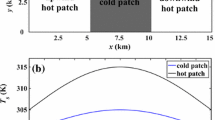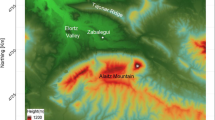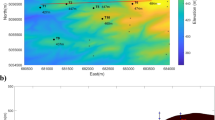Abstract
Above an evaporating heated surface under fair-weather daytime conditions, the cospectra between the vertical velocity component, temperature, and water-vapour mixing ratio should be positive. We have applied a multi-resolution technique to a 3.64-h long, 10-Hz time series centred at midday for 16 fair-weather days at a mid-latitude site during spring to measure the averaging period τc at which the crossover from the domain of the three positive cospectra to a mixed-sign domain occurs. The τc values broadly range from 9 to 42 min, with 13 of the 16 days having values less than 30 min. When mesoscale circulations induced by surface heterogeneity are likely to be present, the vertical heat (or moisture) flux computed with the conventional averaging period of 30 min τ30 is as large (or small) as 1.09 (or 0.78) times that using τc. However, on 14 (or 13) days, the vertical heat (or moisture) fluxes using the period τc are explained by those calculated with the period τ30 within a difference range of ± 1%. The insignificant difference is due to the insensitivity of the fluxes to the averaging period at scales larger than approximately 7 min. Therefore, despite a broad range of τc values, the 30-min-averaged surface fluxes can be treated as the required turbulent fluxes. Although this finding is not robust, given that data were collected at one location over 16 days, it supports the use of 30-min-averaged surfaces fluxes, particularly for the composite midday fluxes on fair-weather days.





Similar content being viewed by others
References
Alekseychik P, Mammarella I, Karpov D, Dengel S, Terentieva I, Sabrekov A, Glagolev M, Lapshina E (2017) Net ecosystem exchange and energy fluxes measured with the eddy covariance technique in a western Siberian bog. Atmos Chem Phys 17:9333–9345
Arya PS (1989) Introduction to micrometeorology. Academic Press, London
Aubinet M, Vesala T, Papale D (2012) Eddy covariance: a practical guide to measurement and data analysis. Springer, New York
Charuchittipan D, Babel W, Mauder M, Leps JP, Foken T (2014) Extension of the averaging time in eddy-covariance measurements and its effect on the energy balance closure. Boundary-Layer Meteorol 152:303–327
de Roode SR, Duynkerke PG, Jonker HJJ (2004) Large-eddy simulation: how large is large enough? J Atmos Sci 61:403–421
Desjardins RL, Macpherson JI, Schuepp PH, Karanja F (1989) An evaluation of aircraft flux measurements of CO2, water vapor and sensible heat. Boundary-Layer Meteorol 47:55–69
Finnigan JJ, Clement R, Malhi Y, Leuning R, Cleugh HA (2003) A re-evaluation of long-term flux measurement techniques part I: averaging and coordinate rotation. Boundary-Layer Meteorol 107:1–48
Foken T, Wimmer MF, Thomas C, Liebethal C (2006) Some aspects of the energy balance closure problem. Atmos Chem Phys 6:4395–4402
Guillemet B, Isaka H, Mascart P (1983) Molecular dissipation of turbulent fluctuations in the convective mixed layer part I: height variations of dissipation rates. Boundary-Layer Meteorol 27:141–162
Hartogensis OK, De Bruin HAR (2005) Monin–Obukhov similarity functions of the structure parameter of temperature and turbulent kinetic energy dissipation rate in the stable boundary layer. Boundary-Layer Meteorol 116:253–276
Howell JF, Mahrt L (1997) Multiresolution flux decomposition. Boundary-Layer Meteorol 83:117–137
Hunt JCR, Kaimal JC, Gaynor JE (1985) Some observations of turbulence structure in stable layers. Q J R Meteorol Soc 111:793–815
Igarashi Y, Kumagai T, Yoshifuji N, Sato T, Tanaka N, Tanaka K, Suzuki M, Tantasirin C (2015) Environmental control of canopy stomatal conductance in a tropical deciduous forest in northern Thailand. Agric For Meteorol 202:1–10
Jonker HJJ, Duynkerke PG, Cuijpers JWM (1999) Mesoscale fluctuations in scalars generated by boundary layer convection. J Atmos Sci 56:801–808
Kaimal JC (1978) Horizontal velocity spectra in an unstable surface layer. J Atmos Sci 35:18–24
Kaimal JC, Businger JA (1963) A continuous wave sonic anemometer-thermometer. J Appl Meteorol 2:156–164
Kaimal JC, Finnigan JJ (1994) Atmospheric boundary layer flows. Oxford University Press, UK
Kaimal JC, Gaynor JE (1983) The Boulder Atmospheric Observatory. J Clim Appl Meteorol 22:863–880
Kaimal JC, Gaynor G (1991) Another look at sonic thermometry. Boundary-Layer Meteorol 56:401–410
Kaimal JC, Eversole RA, Lenschow DH, Stankov BB, Kahn PH, Businger JA (1982) Spectral characteristics of the convective boundary-layer over uneven terrain. J Atmos Sci 39:1098–1114
Kang SL (2016) Regional Bowen ratio controls on afternoon moist convection: a large eddy simulation study. J Geophys Res 121:14056–14083
Kang SL, Bryan GH (2011) A large-eddy simulation study of moist convection initiation over heterogeneous surface fluxes. Mon Weather Rev 139:2901–2917
Kang SL, Ryu JH (2016) Response of moist convection to multi-scale surface flux heterogeneity. Q J R Meteorol Soc 142:2180–2193
Kang SL, Davis KJ, LeMone M (2007) Observations of the ABL structures over a heterogeneous land surface during IHOP_2002. J Hydrometeorol 8:221–244
Lareau NP, Crosman E, Whiteman CD, Horel JD, Hoch SW, Brown WOJ, Horst TW (2013) The persistent cold-air pool study. Bull Am Meteorol Soc 94:51–63
Lee X, Massman W, Law B (2006) Handbook of micrometeorology: a guide for surface flux measurement and analysis. Springer, Berlin
Lundquist JK et al (2017) Assessing state-of-the-art capabilities for probing the atmospheric boundary layer: the XPIA field campaign. Bull Am Meteorol Soc 98:289–314
Ma X, Feng Q, Su Y, Yu T, Jin H (2017) Forest evapotranspiration and energy flux partitioning based on eddy covariance methods in an arid desert region of northwest China. Adv Meteorol 2017:1–10
Mahrt L (1991) Boundary-layer moisture regimes. Q J R Meteorol Soc 117:151–176
Mahrt L (1998) Flux sampling errors for aircraft and towers. J Atmos Ocean Technol 15:416–429
Mahrt L (2010) Computing turbulent fluxes near the surface: needed improvements. Agric For Meteorol 150:501–509
Mao J et al (2018) Southeast atmosphere studies: learning from model-observation syntheses. Atmos Chem Phys 18:2615–2651
Metzger M, Holmes H (2008) Time scales in the unstable atmospheric surface layer. Boundary-Layer Meteorol 126:29–50
Moeng CH, LeMone MA, Khairoutdinov MF, Krueger SK, Bogenschutz PA, Randall DA (2009) The tropical marine boundary layer under a deep convection system: a large-eddy simulation study. J Adv Model Earth Syst 1:1–13
Nilsso EO, Sahlee E, Rutgersson A (2014) Turbulent momentum flux characterization using extended multiresolution analysis. Q J R Meteorol Soc 140:1715–1728
Oncley SP, Businger JA, Friehe CA, Larue JC, Itsweire EC, Chang SS (1990) Surface-layer profiles and turbulence measurements over uniform land under near-neutral conditions. In: Proceedings of 9th symposium on boundary layer and turbulence, Roskilde, Denmark. American Meteorological Society, Boston, pp 237–240
Roth M, Oke TR, Steyn DG (1989) Velocity and temperature spectra and cospectra in an unstable suburban atmosphere. Boundary-Layer Meteorol 47:309–320
Stull RB (1988) An introduction to boundary layer meteorology. Kluwer Academic Publishers, Dordrecht
Vickers D, Mahrt L (1997) Quality control and flux sampling problems for tower and aircraft data. J Atmos Ocean Technol 14:512–526
Vickers D, Mahrt L (2003) The cospectral gap and turbulent flux calculations. J Atmos Ocean Technol 20(5):660–672
Weckwerth TM et al (2004) An overview of the international H2O Project (IHOP_2002) and some preliminary highlights. Bull Am Meteorol Soc 85:253–277
Wilczak JM, Parson DB, Koch SE, Moore JA, LeMone MA, Demoz BD, Flamant C, Geerts B, Wang J, Feltz WF (2001) Sonic anemometer tilt correction algorithms. Boundary-Layer Meteorol 99:127–150
Wyngaard JC, Pennell WT, Lenschow DH, LeMone MA (1978) The temperature-humidity covariance budget in the convective boundary layer. J Atmos Sci 35:47–58
Zhang Z, Tian F, Hu H, Yang P (2014) A comparison of methods for determining field evapotranspiration: photosynthesis system, sap flow, and eddy covariance. Hydrol Earth Syst Sci 18:1053–1072
Zhang H, Ahang H, Cai X, Song Y, Sun J (2016) Contribution of low-frequency motions to sensible heat fluxes over urban and suburban areas. Boundary-Layer Meteorol 161:183–201
Zhao Z, Zhiqiu G, Li Dan, Xueyan B, Chunxia L, Fei L (2013) Scalar flux-gradient relationships under unstable conditions over water in coastal regions. Boundary-Layer Meteorol 148:495–516
Zhou B, Simon JS, Chow FK (2014) The convective boundary layer in the terra incognita. J Atmos Sci 71:2545–2563
Acknowledgements
This work was supported by the National Research Foundation of Korea (NRF) grand funded by the Korea government Ministry of Science and ICT (MSIT) (No. NRF-2018R1A2B6008631). The author also thanks those who collected the surface dataset at the Boulder Atmospheric Observatory (BAO) site during the XPIA field campaign.
Author information
Authors and Affiliations
Corresponding author
Appendices
Appendix 1: Non-stationarity Ratio
Some readers may be concerned about the non-stationarity of the 3.64-h long (217 10-Hz data points) time series, since stationarity is a necessary condition to estimate ensemble-averaged fluxes satisfying the surface energy balance. However, we focus on the measurement of the cut-off time scale that separates turbulent eddies from significant non-turbulent physical processes.
For each day, the 217 10-Hz data points are partitioned into 215-point (about 0.91 h) records, where the number of records (I) is 217−15 = 22 and each record is further divided into J segments. In fact, depending on the segment length τ, the number of segments varies. For example, the number of 214-point (about 27.3 min) segments is two in a 215-point record.
For each day of the 16 fair-weather days, with four 215-point records, we compute the non-stationarity ratio (NR) of Mahrt (1998),
and the random error
In Eq. 18, the within-record standard deviation σwi of the flux for the ith record is computed as
where F(i, j) is the heat or moisture flux for the jth segment of the ith record, and \( \bar{F}\left( i \right) \) is the average of the segment fluxes for the ith record. In Eq. 17, the between-record standard deviation σbtw of the flux is
where \( \bar{F} \) is the segment flux averaged over all of the segments and records.
Figure 6 presents the computed NR values as a function of segment length τ (211 ≤ τ ≤ 214 in 10-Hz data points; \( 3.4 \le \tau \le 27.3 \) min) for each day. The NR value increases to slightly larger than four with τ = 13.7 min on 31 March 2015. However, except for this case, the other values are all smaller than four and further, most values are smaller than two. Mahrt (1998) states that when NR < 2, the residuals of the surface energy budget are less than 20%, but rapidly grow to about 40% and 80% when NR = 3 and 6, respectively.
Appendix 2: Cospectra as Functions of the Normalized Frequency
In the literature, numerous studies (e.g., Kaimal 1978; Roth et al. 1989; Kaimal and Finnigan 1994) present cospectra as a function of the normalized frequency f ≡ 2πz/τV, where V is the wind speed, and z is the measurement height, where z = 5 m above ground level here. Our purpose is to investigate whether the 30-min-averaged surface fluxes are appropriate to be treated as turbulent fluxes. Thus, in Fig. 4, the composite cospectra are obtained as a function of the averaging time scale τ.
For the comparison with previous studies, we present the cospectra as a function of the normalized frequency f. As demonstrated in Table 1, the wind speed V averaged over the 3.64-h period centred at the midday varies for each day. With a higher (or lower) mean wind speed, the normalized frequency becomes relatively lower (or higher). For example, on 16 March 2015 when the mean wind speed of 3.82 m s−1 is the strongest, the cospectra are shifted into the lowest frequency range from 8.2 × 10−1 to 1.3 × 10−5. In contrast, on 11 May 2015, when the mean wind speed of 0.96 m s−1 is the weakest, the cospectra into the highest frequency range from 3.3 × 100 to 5 × 10−5. Thus, the composite cospectra over the 16 days are obtained from the highest f of 3.3 × 100 on 16 March to the lowest f of 5 × 10−5 on 11 May. The composite cospectra of wT and wr normalized with the heat and moisture fluxes both have the cospectral peak at f = 1.3 × 10−2. The spectral peak of the w component is located at 5 × 10−2, and the peaks of T and r at 5 × 10−5. Compared with previous studies (e.g., Kaimal 1978; Roth et al. 1989; Kaimal and Finnigan 1994), the cospectral peaks of ww, wT, and wr are located within the reference ranges, although the spectral peak of the w component is slightly shifted to a higher frequency. In addition, in Fig. 7c, the spectra of T and r have the mesoscale spectral peak at the lowest frequency of f = 5 × 10−5, but the turbulence peak at f = 1 × 10−2, which also matches results of Kaimal and Finnigan (1994).
As Fig. 4 but as a function of the normalized frequency f ≡ 2πz/τM, where z is the measurement height of 5 m, M the wind speed averaged over the 3.64-h period centred at the midday for each day of the 16 fair-weather days (Table 1), and τ is the averaging period. At each value of f from \( 3.3 \times 10^{0} \left( {{\text{the highest }}\,f\, {\text{on }}\,11\, {\text{May}}} \right) \) to \( 5 \times 10^{ - 5} \left( {{\text{the lowest }}\,f\, {\text{on }}\,16\, {\text{March}}} \right) \), the standard deviation range of the cospectra over the 16 days is marked with colour shading
Rights and permissions
About this article
Cite this article
Kang, SL. An Assessment of Eddy-Covariance-Based Surface Fluxes Above an Evaporating Heated Surface Under Fair-Weather Daytime Conditions. Boundary-Layer Meteorol 171, 79–99 (2019). https://doi.org/10.1007/s10546-018-0412-0
Received:
Accepted:
Published:
Issue Date:
DOI: https://doi.org/10.1007/s10546-018-0412-0






